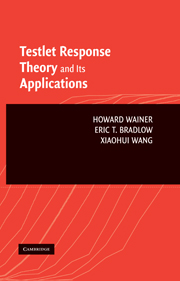Book contents
- Frontmatter
- Contents
- Preface
- PART I INTRODUCTION TO TESTLETS
- PART II BAYESIAN TESTLET RESPONSE THEORY
- PART III TWO APPLICATIONS AND A TUTORIAL
- 13 Using posterior distributions to evaluate passing scores: the PPoP curve
- 14 A Bayesian method for studying DIF: a cautionary tale filled with surprises and delights
- 15 A Bayesian primer
- Glossary of terms
- Epilogue
- Bibliography
- Author Index
- Subject Index
14 - A Bayesian method for studying DIF: a cautionary tale filled with surprises and delights
Published online by Cambridge University Press: 08 January 2010
- Frontmatter
- Contents
- Preface
- PART I INTRODUCTION TO TESTLETS
- PART II BAYESIAN TESTLET RESPONSE THEORY
- PART III TWO APPLICATIONS AND A TUTORIAL
- 13 Using posterior distributions to evaluate passing scores: the PPoP curve
- 14 A Bayesian method for studying DIF: a cautionary tale filled with surprises and delights
- 15 A Bayesian primer
- Glossary of terms
- Epilogue
- Bibliography
- Author Index
- Subject Index
Summary
Introduction
It is a truth universally acknowledged, that an educational researcher in possession of a good data set, must be in want of a Bayesian method.
(Paraphrased, with our apologies, from Jane Austen, 1813)Traditional, frequentist-based, statistical methods have provided researchers with a lens through which they could fruitfully examine the world. These well-known methods for both continuous (e.g., regression) and discrete outcome data (e.g., contingency table procedures) have proved their worth innumerable times. Yet, all methods have limits of applicability and these are no exceptions to that rule. The growth of analogous robust procedures have helped to provide the unwary analyst with protection against unexpected events – usually longer-tailed-than-Gaussian error distributions – but despite the proven robustness of these methods, careful thought must accompany any analysis. If one blindly utilizes statistical methods even those as well established as the Mantel–Haenszel (MH) test considered here, one does so with some risk. The computationally intensive procedures that we have used in fitting the Bayesian testlet models are continually becoming “cheaper and cheaper” and have made a Bayesian approach to many problems a practical lens through which phenomena can be viewed. Such methods provide further protection against the unknown. Remember Donald Rubin's comment, quoted in Chapter 7, that
If you are very smart you can use frequentist methods to solve hard problems, but you can be dumb as a stump and still get the right answer with Bayesian methods.
(Rubin, personal communication, October 26, 2004)In this chapter, we provide a vivid illustration of this in our study of differential item functioning (DIF).
Information
- Type
- Chapter
- Information
- Testlet Response Theory and Its Applications , pp. 219 - 233Publisher: Cambridge University PressPrint publication year: 2007
Accessibility standard: Unknown
Why this information is here
This section outlines the accessibility features of this content - including support for screen readers, full keyboard navigation and high-contrast display options. This may not be relevant for you.Accessibility Information
- 1
- Cited by
